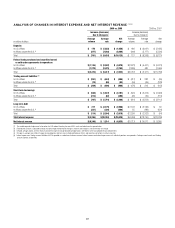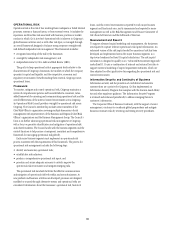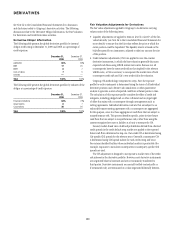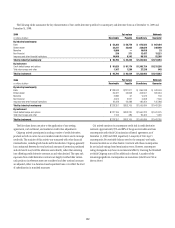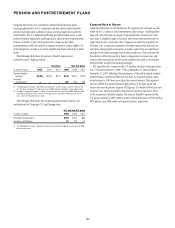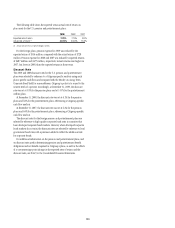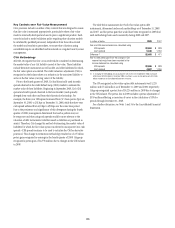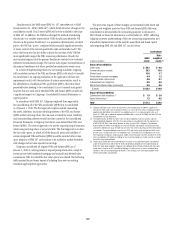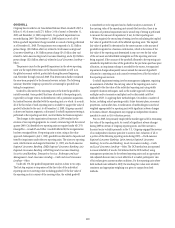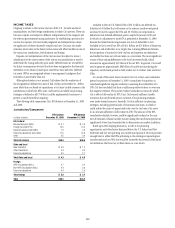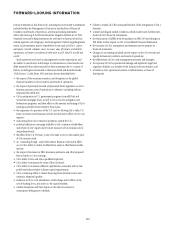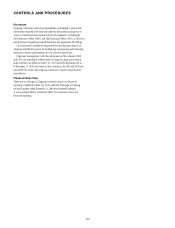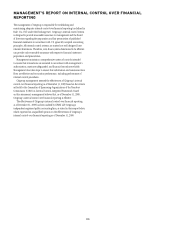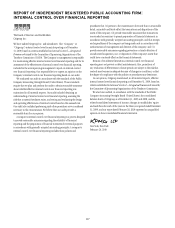Citibank 2009 Annual Report Download - page 117
Download and view the complete annual report
Please find page 117 of the 2009 Citibank annual report below. You can navigate through the pages in the report by either clicking on the pages listed below, or by using the keyword search tool below to find specific information within the annual report.107
ALLOWANCE FOR CREDIT LOSSES
Management provides reserves for an estimate of probable losses inherent in
the funded loan portfolio on the balance sheet in the form of an allowance
for loan losses. These reserves are established in accordance with Citigroup’s
Credit Reserve Policies, as approved by the Audit Committee of the Board
of Directors. Citi’s Chief Risk Officer and Chief Financial Officer review the
adequacy of the credit loss reserves each quarter with representatives from the
Risk Management and Finance staffs for each applicable business area.
During these reviews, the above-mentioned representatives covering the
business area having classifiably managed portfolios (that is, portfolios
where internal credit risk ratings are assigned, which are primarily ICG,
Regional Consumer Banking and Local Consumer Lending) and
modified consumer loans where a concession was granted due to the
borrowers’ financial difficulties, and present recommended reserve balances
for their funded and unfunded lending portfolios along with supporting
quantitative and qualitative data. The quantitative data include:
Estimated probable losses for nonperforming, nonhomogeneous •
exposures within a business line’s classifiably managed portfolio
and impaired smaller-balance homogeneous loans whose terms
have been modified due to the borrowers’ financial difficulties, and
it was determined that a long-term concession was granted to the
borrower. Consideration may be given to the following, as appropriate,
when determining this estimate: (i) the present value of expected future
cash flows; (ii) the borrower’s overall financial condition, resources
and payment record; and (iii) the prospects for support from financially
responsible guarantors or the realizable value of any collateral. When
impairment is measured based on the present value of expected future
cash flows, the entire change in present value is recorded in the Provision
for loan losses.
Statistically calculated losses inherent in the classifiably managed •
portfolio for performing and de minimis non-performing exposures.
The calculation is based upon: (i) Citigroup’s internal system of credit-
risk ratings, which are analogous to the risk ratings of the major rating
agencies; and (ii) historical default and loss data, including rating agency
information regarding default rates from 1983 to 2008, and internal data
dating to the early 1970s on severity of losses in the event of default.
Additional adjustments include• : (i) statistically calculated estimates to
cover the historical fluctuation of the default rates over the credit cycle,
the historical variability of loss severity among defaulted loans, and
the degree to which there are large obligor concentrations in the global
portfolio; and (ii) adjustments made for specifically known items, such as
current environmental factors and credit trends.
In addition, representatives from both the Risk Management and Finance
staffs that cover business areas with delinquency-managed portfolios
containing smaller homogeneous loans (primarily the noncommercial
lending areas of Regional Consumer Banking) present their recommended
reserve balances based upon leading credit indicators, including loan
delinquencies and changes in portfolio size, as well as economic trends
including housing prices, unemployment and GDP. This methodology
is applied separately for each individual product within each different
geographic region in which these portfolios exist.
This evaluation process is subject to numerous estimates and judgments.
The frequency of default, risk ratings, loss recovery rates, the size and
diversity of individual large credits, and the ability of borrowers with foreign
currency obligations to obtain the foreign currency necessary for orderly
debt servicing, among other things, are all taken into account during this
review. Changes in these estimates could have a direct impact on the credit
costs in any quarter and could result in a change in the allowance. Changes
to the reserve flow through the Consolidated Statement of Income on the
lines Provision for loan losses and Provision for unfunded lending
commitments. For a further description of the loan loss reserve and related
accounts, see “Managing Global Risk—Credit Risk” and Notes 1 and 18 to
the Consolidated Financial Statements.
SECURITIZATIONS
Citigroup securitizes a number of different asset classes as a means of
strengthening its balance sheet and accessing competitive financing rates
in the market. Under these securitization programs, assets are transferred
into a trust and used as collateral by the trust to obtain financing. The cash
flows from assets in the trust service the corresponding trust securities. If the
structure of the trust meets certain accounting guidelines, trust assets are
treated as sold and are no longer reflected as assets of Citi. If these guidelines
are not met, the assets continue to be recorded as Citi’s assets, with the
financing activity recorded as liabilities on Citigroup’s balance sheet.
Citigroup also assists its clients in securitizing their financial assets and
packages and securitizes financial assets purchased in the financial markets.
Citi may also provide administrative, asset management, underwriting,
liquidity facilities and/or other services to the resulting securitization entities
and may continue to service some of these financial assets.
Elimination of QSPEs and Changes in the
Consolidation Model for Variable Interest Entities
In June 2009, the FASB issued SFAS No. 166, Accounting for Transfers of
Financial Assets, an amendment of FASB Statement No. 140 (SFAS 166),
that will eliminate Qualifying Special Purpose Entities (QSPEs). SFAS 166 is
effective for fiscal years that begin after November 15, 2009. This change will
have a significant impact on Citigroup’s Consolidated Financial Statements.
Beginning January 1, 2010, Citigroup will lose sales treatment for certain
future asset transfers that would have been considered sales under SFAS 140,
and for certain transfers of portions of assets that do not meet the definition
of participating interests.


